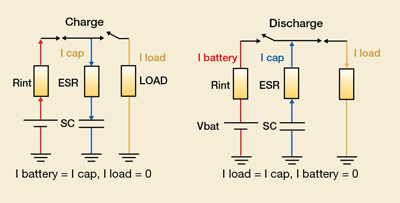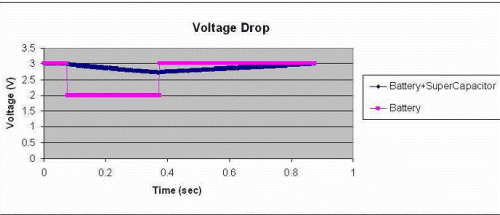Some devices require high-current power pulses that only double-layer capacitors can support
BY MARK GEBBIA
Illinois Capacitor, Lincolnwood, IL
http://www.illinoiscapacitor.com/
SEMION SIMMA, and ELY ALON
Cellergy, Migdal Haemek, Israel
http://cellergycap.com/
Applications in electronics are constantly growing in diversity. In recent years, there has been a growing demand for very compact, battery-powered portable devices. Fueling that growth has been a steady improvement in the capabilities and cost effectiveness of rechargeable lithium batteries. Even with the advancements in battery technology, the developments have limits and improvements have slowed.
Many battery-powered devices have power needs that vary greatly as their mode of operation changes. Some need high-current power pulses that may be difficult or impossible for batteries to supply without increasing the risk of performance failures, reduced operational life, or even premature battery failures. The problem is that batteries have high internal resistances (such as ESR) too large to continue to consistently deliver high-power pulses. Devices that would require high-power pulses include:
• GPS tracking systems.
• Bluetooth communications devices.
• LED safety flashers.
• Bar-code equipment.
• Remote-control systems.
• Automatic meter readers (AMRs).
• RFID equipment.
• Medical equipment.
• Alarm and security systems.
• Portable music players and other audio amplifiers.
For some, there is a need to transmit data for only a few milliseconds each minute. The pulse currents during transmission range from 20 to 50 mA. While batteries are high-energy devices, they have difficulties delivering such short high-pulse currents without the battery becoming damaged, especially at low temperatures.
It is well known that adding supercapacitors in parallel with the source battery can help supply power during these pulses. As supercapacitors have become more cost effective, they have found an increasing use in this role.
An early use of supercapacitors was in auto sound systems with heavy bass. A 12-V car battery cannot sufficiently produce the momentary power to satisfy the needs of these stadium-level sound systems without causing the vehicle battery to fail after only a few months of usage. Adding a supercapacitor of a few farads across the battery is sufficient to maintain the bone-jarring sound pressure levels and save the battery from a premature failure!
Supercapacitor app
Placing a supercapacitor, with its huge storage capabilities, in parallel with a battery can easily supply almost any required pulse currents. After delivering the pulse current, the supercapacitor is quickly recharged by the battery between the pulse cycles. This reduces the stress on the battery, extending the overall life of the battery by a factor of three or more, compared to not having the supercapacitor in the circuit. Figure 1 illustrates this principle.

Fig. 1. Battery-powered pulse circuit.
Supercapacitors, also called EDLCs (electrochemical double layer capacitors) or ultracapacitors, are electrochemical devices that have high capacitance and high energy density compared to other common capacitors, such as tantalum and aluminum electrolytic types. Compared to lithium batteries, supercapacitors have up to 10 times the power density.
Being high-energy devices, batteries have an advantage over supercapacitors. They can deliver more energy over a longer time in a more efficient package than supercapacitors. There are applications, such as windmills, where supercapacitors are a superior choice over batteries for other reason other than energy storage efficiency. Supercapacitors on the other hand are high-power devices able to deliver a large amount of energy in a very short time.
Supercapacitors have been commercially available since 1978 at first, these were low-voltage devices that had high ESR and were primarily designed for computer backup applications. Since then, they have gone through considerable technical and manufacturing changes, to the point that there are several types commercially available. While terminology may vary, most supercapacitors fit into one of these categories: (1) Pseudocapacitor, (2) Prismatic, or (3) Pulse or battery support.
All supercapacitors are basically constructed from two carbon-based electrodes (mostly activated carbon having very high surface area), an electrolyte (aqueous or organic) and a separator that allows the transfer of ions, while providing electronic insulation between the electrodes.
Most high-energy and high-power supercapacitors are produced in a way that is similar to that of aluminum electrolytic capacitors. Producing supercapacitors using established mounting configurations allows designers to select parts that have screw terminals, radial leaded through-hole parts, in straight lead and snap-in lead styles, as well as surface-mount styles. This offers tremendous flexibility for designers to apply supercapacitors in their designs.
While basic appearances may be similar, supercapacitors store energy in a different way than electrolytic capacitors. As voltage is applied to a supercapacitor, ions in the electrolyte solution diffuse across the separator into the pores of the electrode of opposite charge.
Charge accumulates at the interface between the electrodes and the electrolyte; forming two charged layers (double layer) with a separation distance of just a few angstroms ( 0.1 nm). This is the distance between the electrode surfaces to the center of the ion layer. Since the capacitance value is proportional to the surface area and is the reciprocal of the distance between the two layers, high capacitance values can be achieved in a very small space.
Not all supercapacitors are suitable for all applications. For example, the larger pseudo and prismatic supercapacitors cannot be used in pulse applications because these capacitors have:
• Capacitance values too high (>1 F).
• Rated voltage too low.
• Internal ESRs to large.
• Electrolyte not environmentally friendly (ACN).
• Physical dimensions form factor not correct.
• High cost.
Flat-style supercapacitors
The form factor of typical supercapacitors precludes their use in pocket-sized instruments. To overcome this shortfall, several capacitor manufacturers have developed flat-style supercapacitors, designed specifically for battery support applications.
Most are rectangular or square in shape, are quite thin, encapsulated in an aluminum foil packet or rigid metal shell and can be surface mounted or stood on end as any other radial-leaded device would be. While each relies on some similarities in the physics of how they function, and each typically delivers up to 1-F capacity, production methods, chemistry and package construction can vary. This in turn affects cost and the suitability for different applications.
One of the newest approaches is a patented automated manufacturing process, developed for Illinois Capacitor by Cellergy. This process is the first to be based on conventional printing techniques, thereby overcoming the high-cost factor often associated with supercapacitors. As in the case of the other flat devices, this process has been developed specifically for the production of supercapacitors for pulse/battery support applications.
A key component of the process is a proprietary, printable aqueous electrode paste using activated carbon. This is printed with an electrode matrix structure on an electronically conductive film. The electrodes are then encapsulated with a porous ionic conducting separator, and another electrode matrix is then printed on the separator. This process is repeated as often as required, enabling customization of the product to the specifications of the end user. This customization (see Fig. 2 ) can allow the device to be made in almost any shape or size, for maximum use of available space.

Fig. 2. Example of customized two-layer wafer with 1.4-V capacitor.
In addition to greater cost effectiveness and flexibility of form, capacitors constructed using this printing technology typically offers:
• Lower ESR values — up to 50% less.
• Higher-rated voltages — up to 12 Vdc.
• Low leakage currents in a shorter amount of time — 12-hour specification versus 72-hour specification for similar types of supercapacitors.
• Sturdy encasement in a metal shell, with epoxy end-fills (versus aluminum foil packet).
• Nonpolarized.
• Better temperature stability at low temperature.
• Long life — 500,000 pulses.
• Environmentally friendly (aqueous electrolyte vs. ACN in pseudo capacitors).
Higher-rated voltage eliminates the need to connect parts in series with balancing resistors. The landscape of this capacitor market segment is growing rapidly because of the need for compact portable power. Developments are continuing with supercapacitors to overcome some of the factors currently limiting their use. Increases in the operating voltages and maximum operating temperature are goals of capacitor designers, as well as making the electrolytes, particularly for pseudocapacitors, more environmentally friendly.
Battery support
The biggest challenge for designers of battery-powered circuits is to limit the voltage drop in their designs. Obviously when the voltage drop in the circuit is too large, the device will not function properly. Too large a voltage change will cause the internal passivation layer of the lithium battery to breakdown, leading to higher leakage currents and result in shortened battery life. In the case of low ambient temperatures, the internal resistance of the battery would increase dramatically, further shortening battery life.
By connecting supercapacitors in parallel with the battery, the supercapacitors reduce the voltage drop that would occur in the battery, which in turn dramatically increasing its life. Figure 3 illustrates this effect.

Fig. 3. Voltage drop of battery alone vs. battery plus supercapacitor.
Here are examples of how a supercapacitor reduces the battery voltage drop:
Example 1. Battery operated passive RFID
Typical pulse details: Regular RFID pulse transmission is 30 mA, expected pulse width is 50 ms, and typical period is 1 min.
Requirements: Maximum allowed voltage drop is 1 V.
Solution without supercapacitor :
Voltage drop calculation:
I = Peak pulse current = 0.03 A
Typical lithium battery internal resistance (BIR) = 50 Ω
∆t = Pulse width (50 msec)
The total voltage drop is given by: [VDROP = I*BIR]
VDROP = 0.03 A * 50 Ω = 1.5 V (larger than the max. 1 V required)
VOUT = 3.6 V – 1.5 V = 2.1 V
Solution with supercapacitor:
Voltage drop calculation:
ESR = Supercapacitor internal resistance: (ESR= 360 mΩ)
C = supercapacitor capacitance, (C = 20 mF)
The total voltage drop is given by: [VDROP = I*ESR + ∆t*I/C]
VDROP = 0.03 A * 0.36 Ω + 0.05 s * 0.03 A/0.02 F =~ 0.1V
VOUT = 3.6 V – 0.1 V = 3.5 V
Example 2. AMR – automatic meter reader
Advantage: Supercapacitor extend AMR’s battery lifetime to 10 to 15 years!
Typical pulse details: Regular AMR signal is 30 mA, expected pulse width is 300 ms, and typical period is 1 min (enough time to charge supercapacitor).
Requirements: Maximum allowed voltage drop 300 mV.
Solution with supercapacitor:
Voltage drop calculation:
I = Peak pulse current (0.03 A)
ESR = Supercapacitor internal resistance: (ESR= 180 mΩ)
∆t = Pulse width (300 ms)
C = Supercapacitor capacitance, (C = 40 mF)
The total voltage drop is given by: [VDROP = I * ESR + ∆t * I/C]
VDROP = 0.03 A * 0.18 Ω + 0.3 s * 0.03 A/0.04 F = 0.23 V
VOUT = 3.6 V – 0.23 V = 3.37 V
As demonstrated in the examples cited, supercapacitors can increase circuit performance and prolong the life of batteries. This can add value to the end-product and ultimately reduce the costs to the customer by reducing the amount of batteries needed and the frequency of the replacement of the batteries.
The low-profile form factor of flat supercapacitors now makes it possible to add supercapacitor battery support to compact portable devices and other circuitry where available space is limited. The chemistry behind the newest pulse or battery-support supercapacitors, being more environmentally friendly, will find increasing acceptance in portable power devices where environmental concerns of high importance.
In addition, because they have a long life and extend the operating life of the batteries they support, they contribute greatly to the environmental friendliness of the end-product, while reducing maintenance costs. With these strong benefits, flat supercapacitors should be considered whenever a battery-powered portable device meets the profile we’ve described. ■
Advertisement
Learn more about Illinois Capacitor





